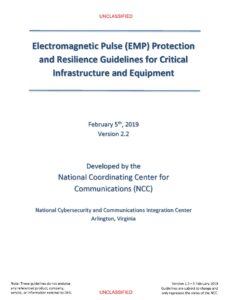Electromagnetic Pulse (EMP) Protection and Resilience Guidelines
Electromagnetic Pulse (EMP) Protection and Resilience Guidelines for Critical Infrastructure and Equipment
Department of Homeland Security, National Coordinating Center for Communications (NCC). National Cybersecurity and Communications Integration Center
CLICK HERE TO DOWNLOAD: Electromagnetic Pulse (EMP) Protection and Resilience Guidelines for Critical Infrastructure and Equipment
Version 2.2 – 5 February 2019
Guidelines are subject to change and
only represent the views of the NCC.
Executive Overview:
This document provides guidelines to assist federal, state, and local officials and critical infrastructure owners and operators to protect mission essential equipment against electromagnetic pulse (EMP) threats. It was created to help fulfill the Secretary of Homeland Security’s responsibilities to:
- “… provide strategic guidance, promote a national unity of effort, and coordinate the overall Federal effort to promote the security and resilience of the Nation's critical infrastructure.” [Presidential Policy Directive 21 - Critical Infrastructure Security and Resilience]
- “… ensure … the necessary combination of hardness, redundancy, … to obtain, to the maximum extent practicable, the survivability of NS/EP {national security/emergency preparedness} communications …” [Executive Order 13618, Assignment of National Security and Emergency Preparedness Communications Functions]
- “… be the focal point within the Federal Government for all EMP technical data and studies concerning telecommunications.” [Title 47 Part 215 of the Code of Federal Regulations (CFR)]
These guidelines also respond to the U.S. Congressional EMP Commission’s recommendation that the “Department of Homeland Security should play a leading role in spreading knowledge of the nature of prudent mitigation preparations for EMP attack to mitigate its consequences.” [Report of the Commission to Assess the Threat to the United States from Electromagnetic Pulse (EMP) Attack, Critical National Infrastructures, page 181, 2008]. The Department of Homeland Security (DHS) takes seriously the findings of this Commission, such as:
“The critical national infrastructure in the United States faces a present and continuing existential threat from combined-arms warfare, including cyber and manmade electromagnetic pulse (EMP) attack, as well as from natural EMP from a solar superstorm. During the Cold War, the U.S. was primarily concerned about an EMP attack generated by a high-altitude nuclear weapon as a tactic by which the Soviet Union could suppress the U.S. national command authority and the ability to respond to a nuclear attack—and thus negate the deterrence value of assured nuclear retaliation. Within the last decade, newly-armed adversaries, including North Korea, have been developing the ability and threatening to carry out an EMP attack against the United States. Such an attack would give countries that have only a small number of nuclear weapons the ability to cause widespread, long-lasting damage to critical national infrastructures, to the United States itself as a viable country, and to the survival of a majority of its population.”
Assessing the Threat from Electromagnetic Pulse (EMP), Executive Report, July 2017
There are four EMP Protection Levels defined herein, as outlined in Table 1. These levels were initially developed at the request of the federal Continuity Communications Managers Group (CCMG), but are applicable to any organization that desires to protect its electronics and critical infrastructures. For additional background on EMP, a set of reports can be found at "www.firstempcommission.org" that includes information about high-altitude EMP (HEMP), Source Region EMP (SREMP), and Intentional Electromagnetic Interference (IEMI) EMP.

